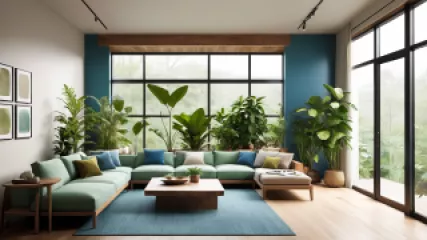How to Design a Healing Environment for Mental Well-being
How to Design a Healing Environment for Mental Well-being
In today's fast-paced world, our physical surroundings have a profound impact on our mental health and overall well-being. The concept of a "healing environment" has gained significant traction in the field of psychology, as researchers and healthcare professionals recognize the vital role that space and design play in supporting individual and community-wide mental health. In this comprehensive guide, we will explore the psychology of space and uncover practical strategies for designing a healing environment that promotes mental well-being.
Understanding the Psychology of Space
The relationship between our physical environment and our mental state is a complex and multifaceted one. Our surroundings, from the colors on the walls to the layout of a room, can significantly influence our emotions, thoughts, and overall sense of well-being. This phenomenon is known as the psychology of space, and it is a crucial consideration when creating a healing environment.
At the core of the psychology of space is the idea that our physical environment can either support or hinder our mental and emotional needs. A well-designed space can foster a sense of calm, focus, and connection, while a poorly designed space can contribute to feelings of anxiety, distraction, and isolation. By understanding the various psychological factors that shape our experience of a space, we can intentionally create environments that promote mental well-being.
Elements of a Healing Environment
Designing a healing environment involves carefully curating a range of elements that work together to support mental health and emotional well-being. Let's explore some of the key components that contribute to a truly healing space:
Lighting
Lighting is a fundamental element of a healing environment. Proper lighting can profoundly influence our mood, energy levels, and overall sense of well-being. Incorporating natural light, where possible, can have a calming and uplifting effect, while strategic use of artificial lighting can create a warm and inviting atmosphere. Adjustable lighting options, such as dimmable fixtures, can allow individuals to customize the lighting to their personal preferences and needs.
Color Palette
The colors we surround ourselves with can have a significant impact on our emotional state and cognitive function. Warm, earthy tones like greens, blues, and neutrals can promote a sense of calm and relaxation, while vibrant hues may energize and stimulate. Choosing a color palette that is soothing and harmonious can contribute to a healing environment.
Spatial Layout
The way a space is organized and designed can greatly influence our ability to focus, connect, and find solace. An open, uncluttered layout with clear pathways and defined zones can foster a sense of tranquility and ease, while a cramped or cluttered environment can contribute to feelings of stress and overwhelm. Incorporating elements like flexible furniture arrangements, private nooks, and communal gathering spaces can create a versatile and adaptable healing environment.
Biophilic Design
Biophilic design is the integration of nature and natural elements into the built environment. Exposure to natural materials, textures, and forms can have a profoundly calming and restorative effect on our minds and bodies. Incorporating elements like indoor plants, natural wood, and water features can create a soothing and rejuvenating atmosphere.
Sensory Experiences
The way we experience a space through our senses can significantly impact our mental and emotional state. Thoughtfully curated sensory experiences, such as calming scents, gentle background music, and tactile surfaces, can contribute to a healing environment. By catering to the senses, we can create an immersive and therapeutic experience that supports mental well-being.
Designing a Healing Environment
With an understanding of the psychology of space and the key elements that contribute to a healing environment, let's explore a step-by-step process for designing a space that promotes mental well-being:
Step 1: Assess the Space
Begin by thoroughly evaluating the existing space, taking into account factors such as size, layout, lighting, and any existing design elements. Consider the intended purpose of the space and the specific needs of the individuals who will be using it. This assessment will help inform your design decisions and ensure that the final result aligns with the desired goals.
Step 2: Establish a Calming Aesthetic
Choose a color palette that is soothing and harmonious, incorporating natural tones and textures that evoke a sense of tranquility. Incorporate natural elements, such as plants, natural wood, and water features, to create a biophilic design that connects the space to the natural world. Ensure that the overall aesthetic is visually appealing and promotes a sense of calm and relaxation.
Step 3: Optimize Lighting
Carefully consider the lighting in the space, prioritizing natural light whenever possible. If natural light is limited, strategically place artificial lighting to create a warm and inviting atmosphere. Incorporate dimmable fixtures and adjustable lighting options to allow for customization and adaptation to individual needs.
Step 4: Curate Sensory Experiences
Enhance the healing environment by catering to the senses. Incorporate calming scents, such as essential oils or natural fragrances, to create a soothing olfactory experience. Introduce gentle background music or nature sounds to create a serene auditory landscape. Incorporate tactile elements, like soft fabrics or natural materials, to encourage a positive sensory connection with the space.
Step 5: Foster Spatial Connectivity
Design the layout of the space with intentionality, ensuring that it supports both individual and communal needs. Create defined zones for private contemplation, social interaction, and group activities, allowing for flexibility and adaptability. Incorporate elements that encourage movement, such as walking paths or meditation areas, to promote a sense of physical and mental well-being.
Step 6: Encourage Personalization
Empower individuals to personalize their experience within the healing environment. Provide opportunities for self-expression, such as dedicated art or writing spaces, to foster a sense of ownership and connection to the space. Encourage the use of personal mementos, photographs, or other meaningful items to further personalize the environment and create a sense of comfort and familiarity.
Step 7: Maintain and Evolve the Space
A healing environment is not a static entity; it requires ongoing maintenance and evolution to ensure its continued effectiveness. Regularly assess the space, gather feedback from users, and make adjustments as needed to address changing needs and preferences. Incorporate opportunities for collaboration and community input to foster a sense of shared ownership and investment in the space.
Conclusion
Designing a healing environment that promotes mental well-being is a multifaceted and deeply rewarding endeavor. By understanding the psychology of space and incorporating key elements such as lighting, color, spatial layout, biophilic design, and sensory experiences, we can create environments that foster a sense of calm, focus, and connection. This holistic approach to healing environments not only benefits individuals but can also contribute to the overall well-being of communities and societies as a whole.
As we navigate the complexities of modern life, the need for spaces that support mental health and emotional resilience has never been more pressing. By embracing the principles of healing environment design, we can empower individuals to find respite, cultivate self-awareness, and nurture their mental well-being. The journey towards creating a healing environment is one of mindfulness, creativity, and a deep commitment to supporting the holistic health and happiness of those who inhabit these spaces.






